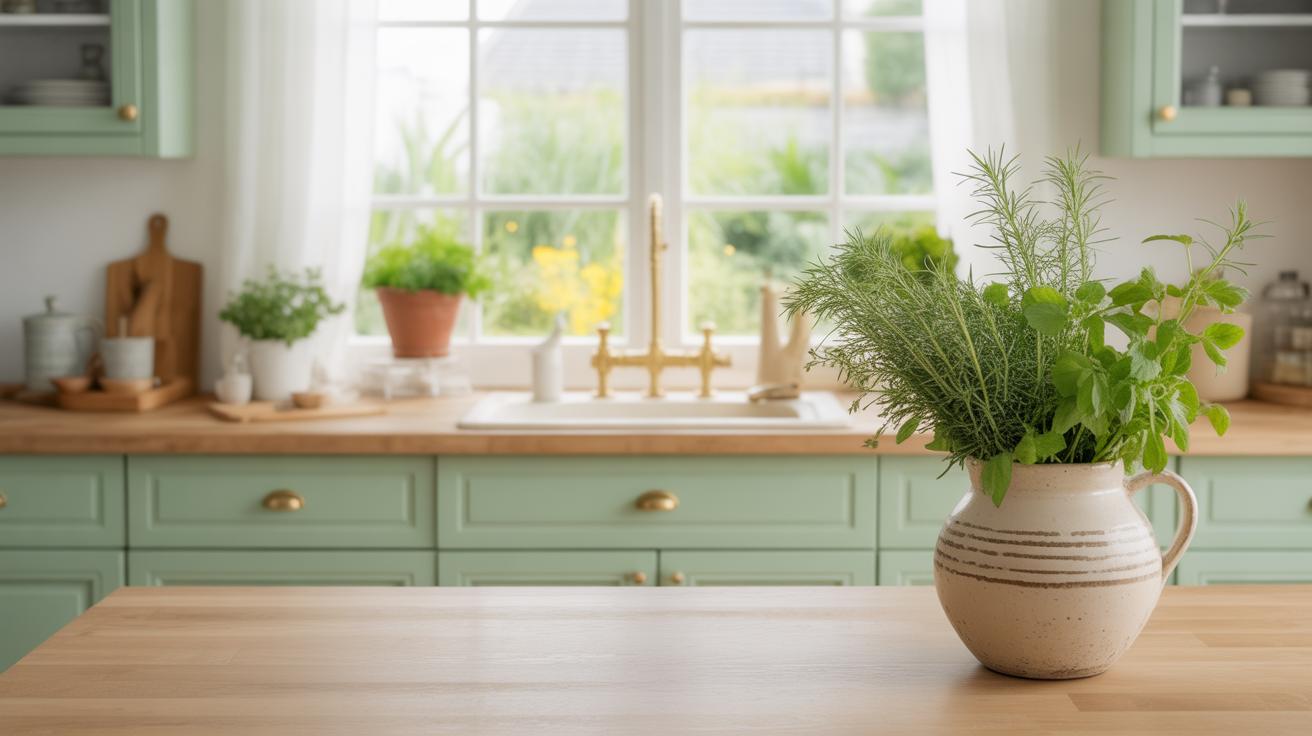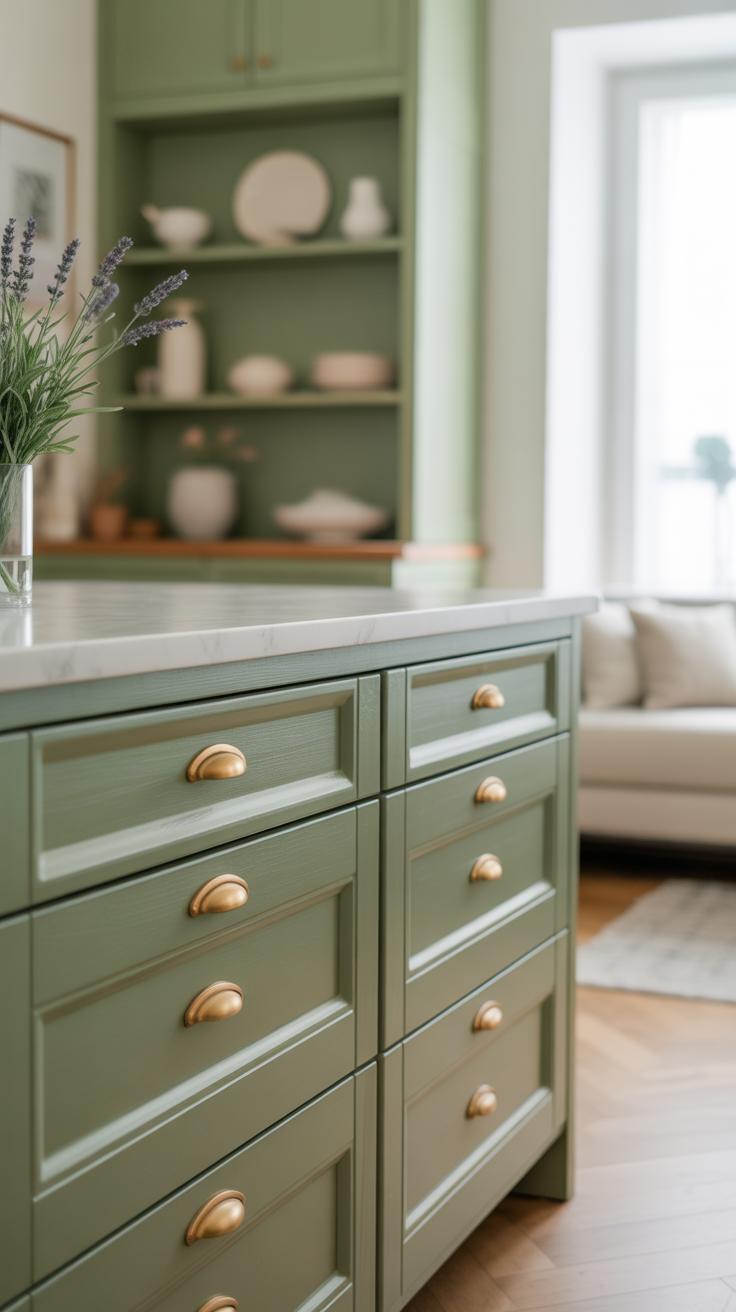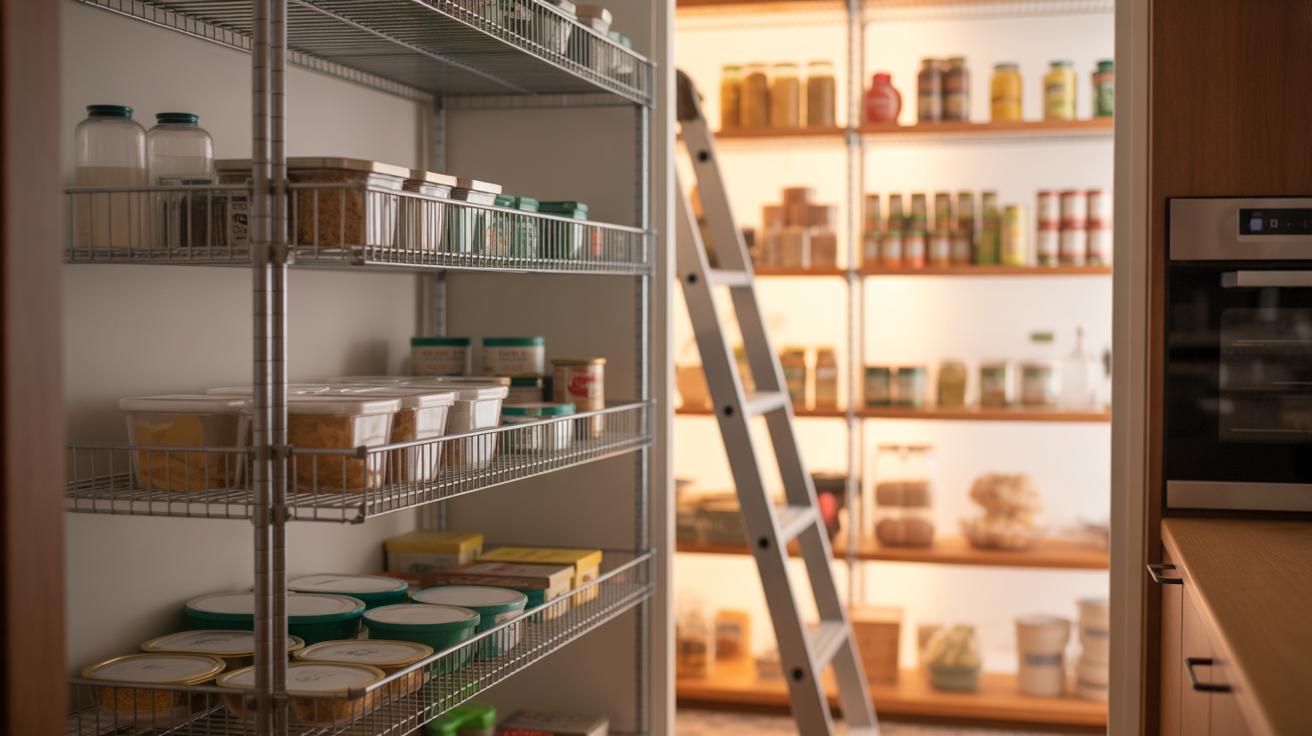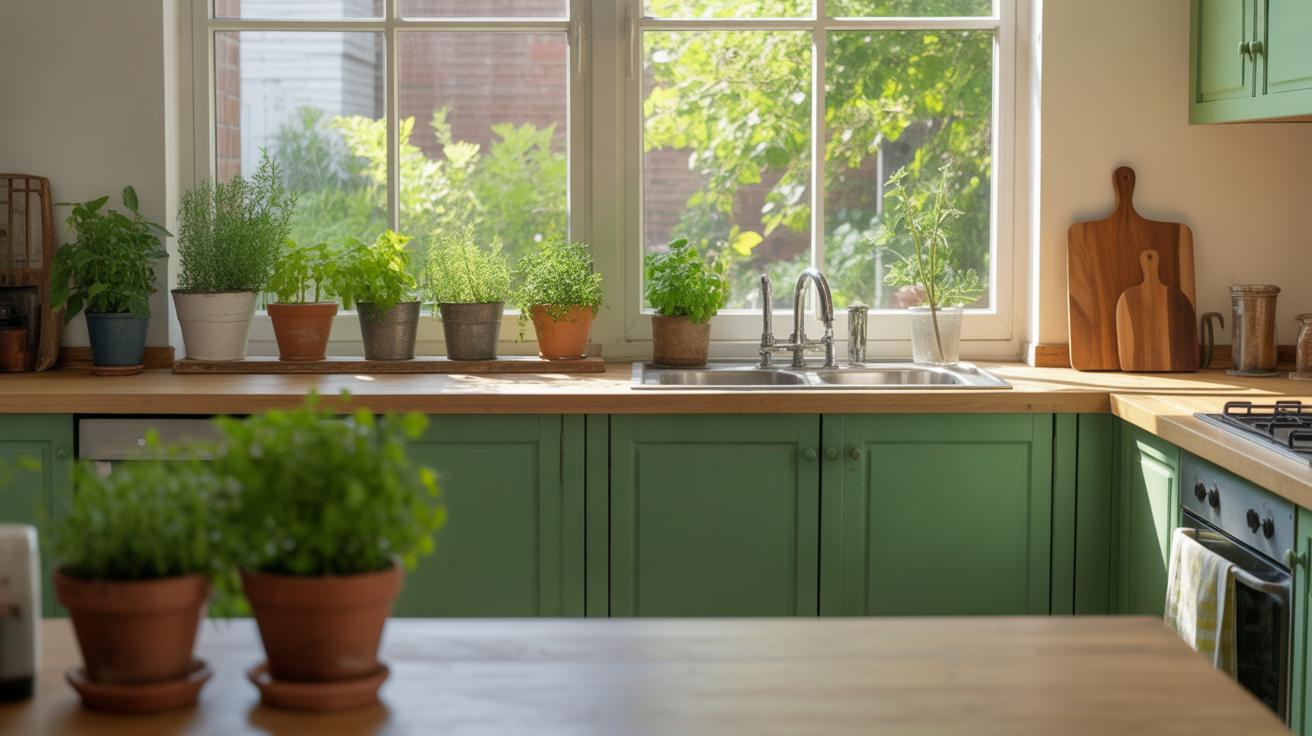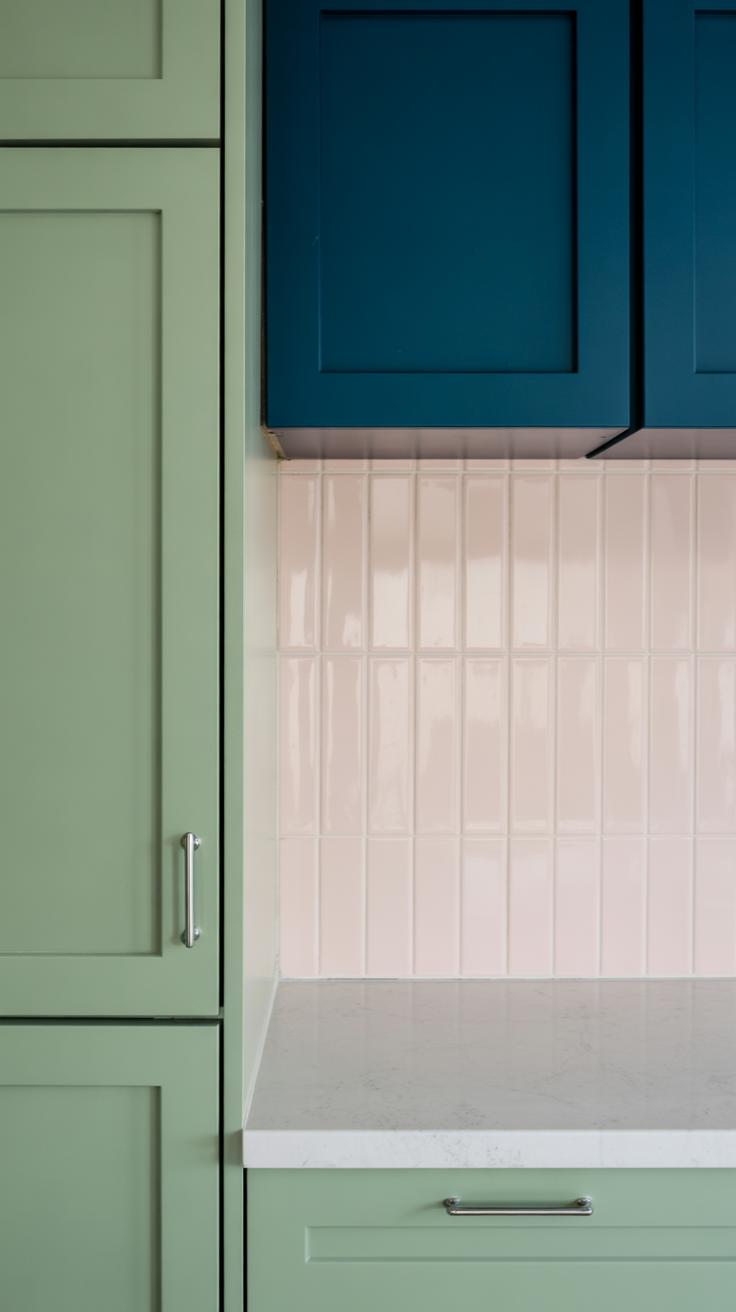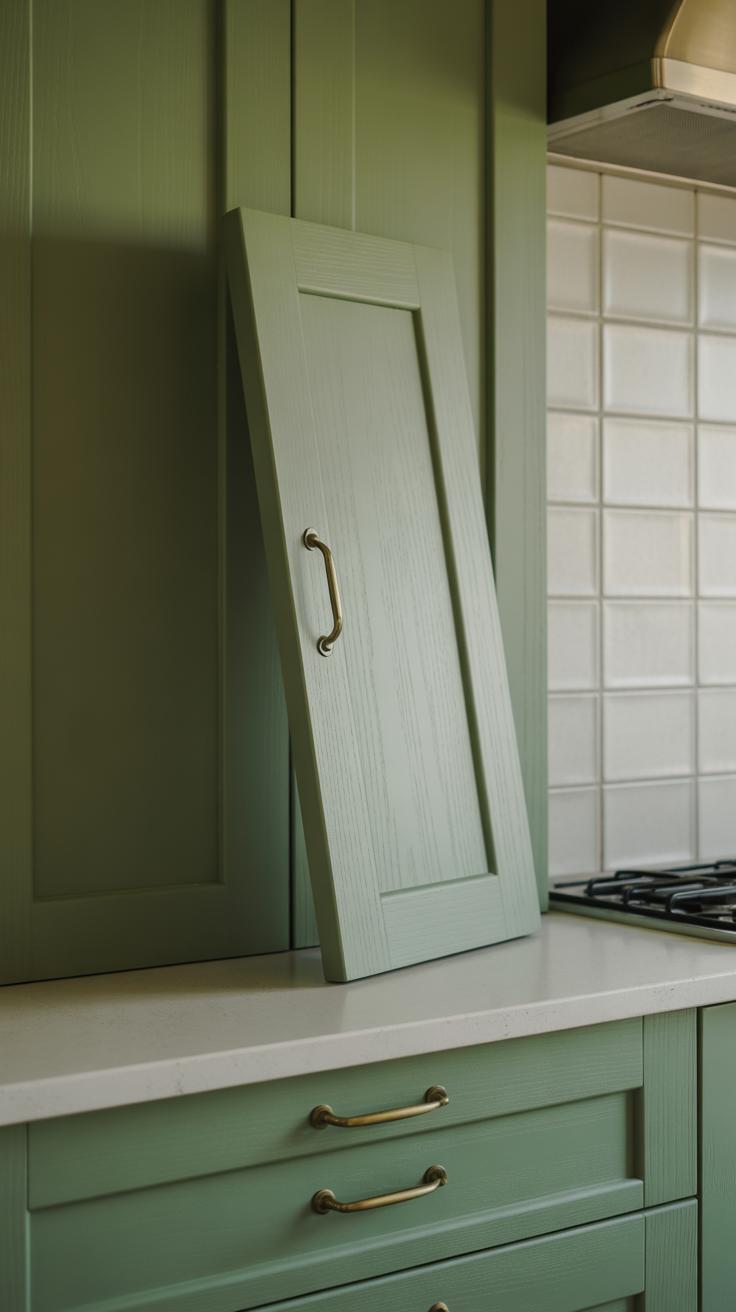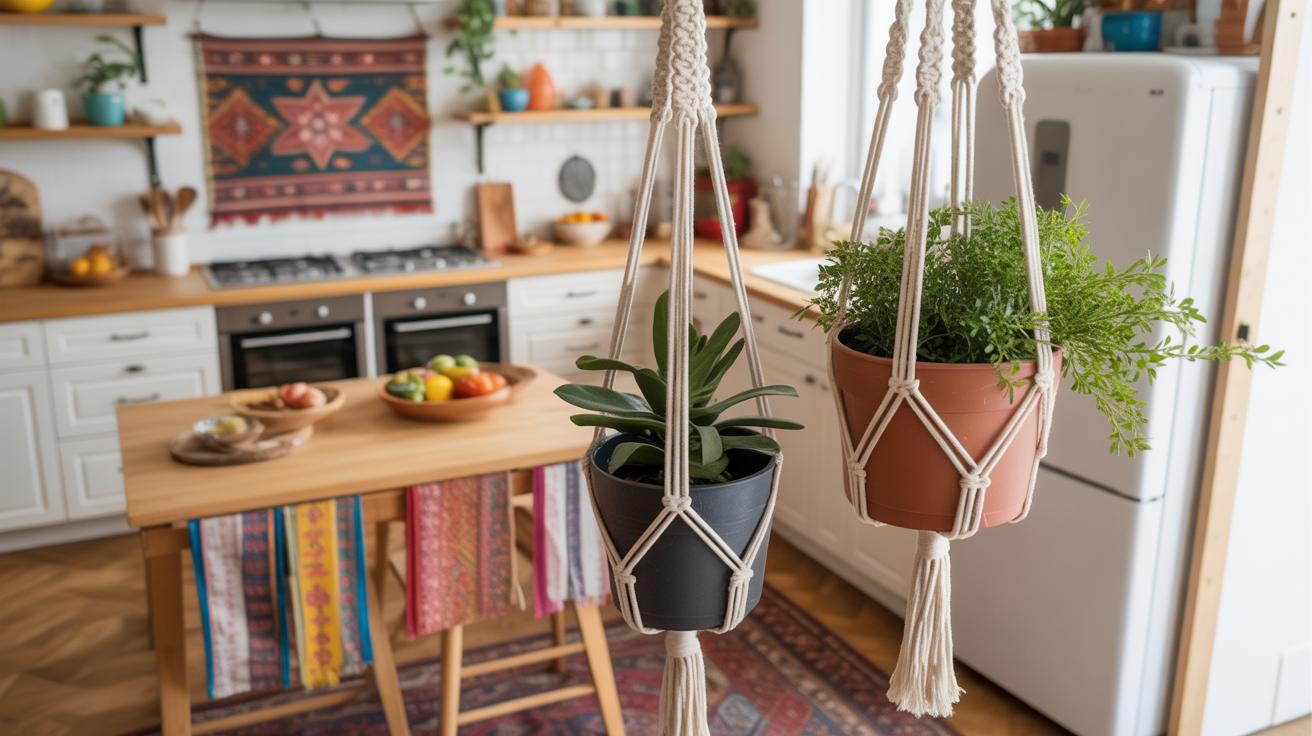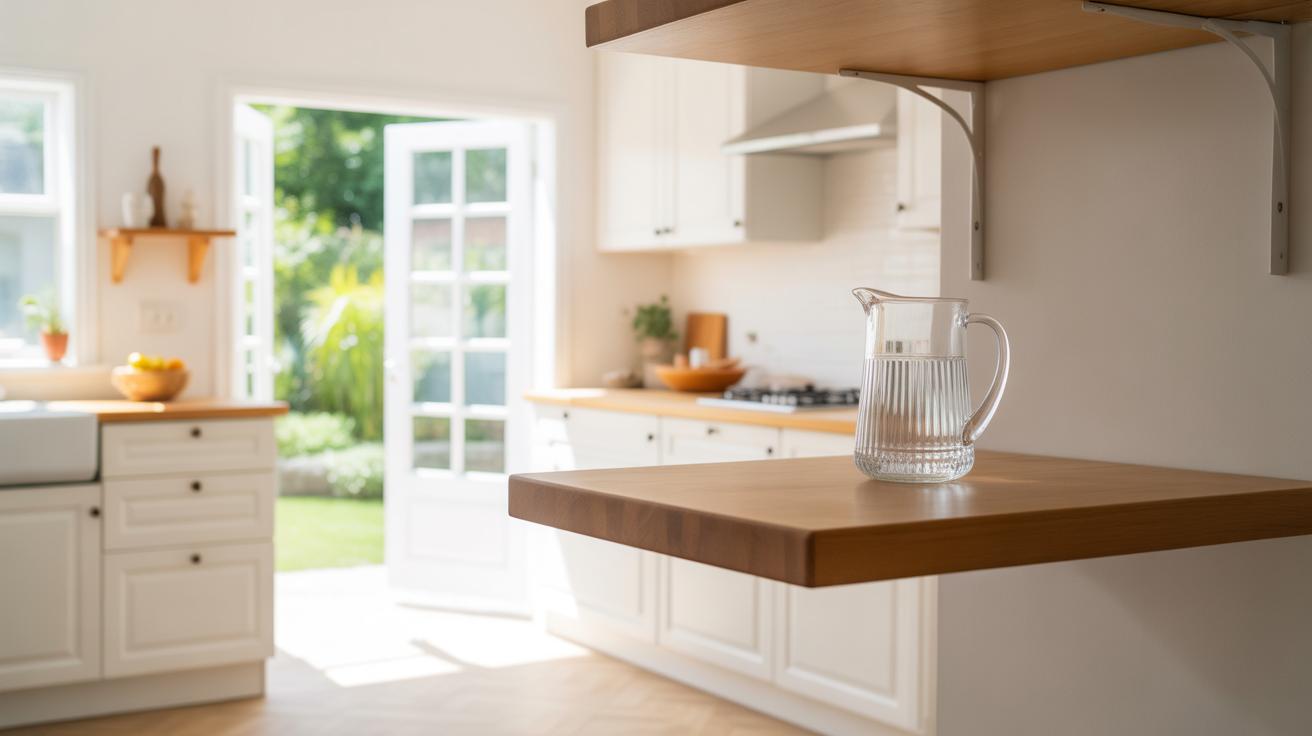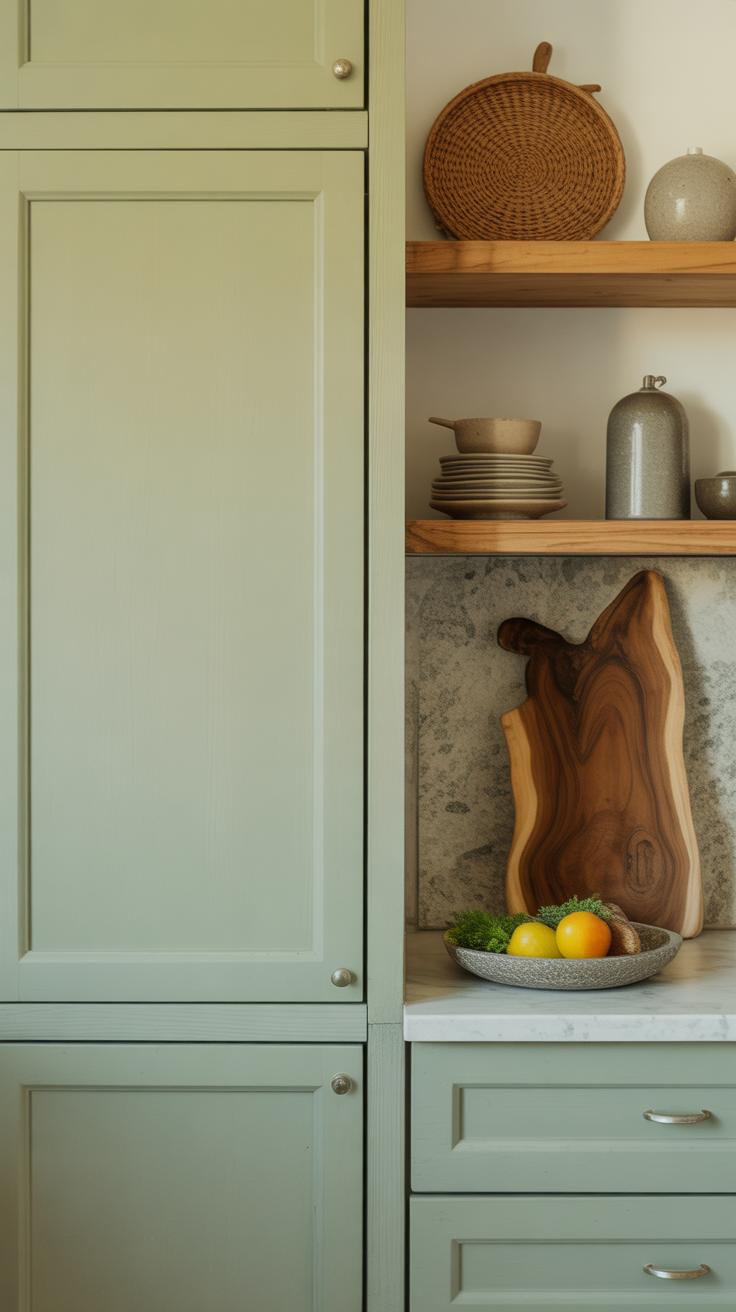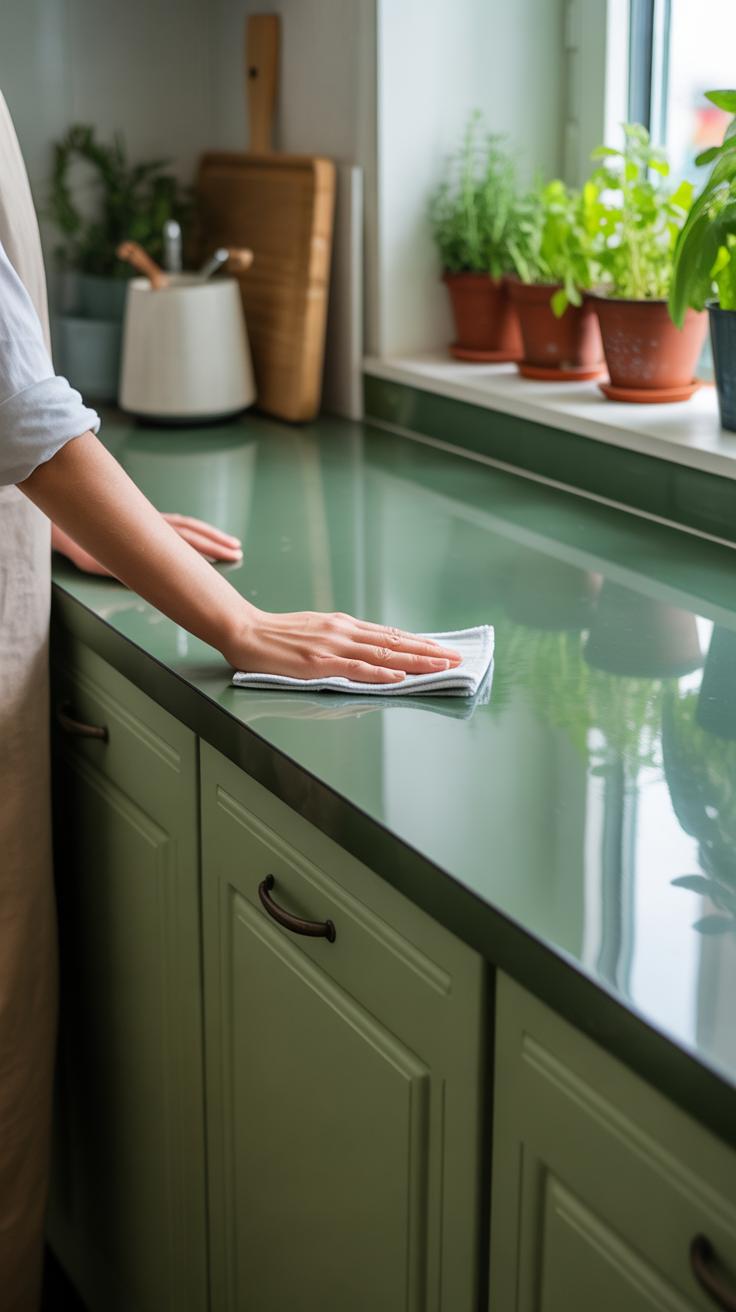Introduction
Your kitchen is more than just a place to cook. It is a heart of your home where you gather and create. Choosing the right color can change how you feel in this space. Sage green is a soft, calming color. It resembles the leaves of the common sage plant, a gentle mix of green and gray. This color brings a peaceful and natural touch to your kitchen.
This article will explore how you can use sage green to make your kitchen a relaxing and stylish place. You will find ideas for design, decoration, and choosing matching colors. Plus, we will look at how sage green connects with nature and supports a calm home atmosphere. Let’s discover ways to bring this tranquil color into your kitchen.
Why Choose Sage Green for Your Kitchen
You might find it surprising how a color like sage green can subtly change the whole atmosphere of your kitchen. It’s not just about looking nice; it’s about how the space makes you feel. Sage green softens the usually busy and functional kitchen environment, turning it into a place that feels less rushed and more grounded.
This color tends to work well with natural materials—think wood or stone—which means it blends rather than clashes. When you have sage green walls or cabinets, you invite a sense of quiet balance, almost like the room breathes with you. It feels familiar but not dull, calming without being cold.
Another interesting aspect is that sage green doesn’t compete with your kitchen accessories or food colors. It acts more like a backdrop that helps other elements stand out, such as copper pots, herbs on the windowsill, or even your favorite patterned dishware. You can change small accents over time without having to rethink the whole color scheme.
- Creates a relaxed kitchen vibe, making it easier to unwind while cooking.
- Works with a variety of textures and finishes, so you’re not boxed in stylistically.
- Supports a harmonious look that can adapt from rustic to modern.
- Stands up to changing seasons, feeling fresh in spring and cozy in winter.
When you think about the kitchen as the heart of your home, a quiet and inviting color like sage green might be exactly what you need to keep things feeling calm but alive. Have you noticed how certain colors just change your mood? Sage green has that type of subtle influence.
Creating a Calm and Inviting Space
Sage green has this unusual way of softening a kitchen’s vibe without making things feel dull or boring. There’s a quiet calmness to it that almost invites you to slow down, which is nice when the kitchen tends to be the busiest room in the house. You might notice that your guests linger longer or your family feels more at ease just because of that subtle color warmth. It’s kind of surprising how a color can affect mood so gently, yet so effectively.
It’s not overwhelming, which makes it easy to pair with different textures and materials. Whether you use it on cabinets, walls, or even kitchen accessories, sage green doesn’t shout—it whispers. That whisper, though, is enough to make the kitchen feel welcoming. I guess it’s a little like having a quiet conversation instead of a loud one, something calming but present.
The Connection to Nature
There’s something about sage green that brings the outdoors inside, almost like a subtle reminder of fresh leaves or soft moss. That connection to nature can create a sense of well-being in your kitchen space, making it feel less artificial. Maybe it’s why people tend to relax more when they’re around plants—sage green taps into that vibe without needing actual greenery.
When you spend time cooking or eating in a space that feels linked to nature, it somehow changes your experience. It’s not just about aesthetics; it’s about how the colors make you feel safe and grounded. Of course, this might depend on how much you like natural elements, but sage green offers a gentle nudge in that direction, whether you notice it consciously or not.
Would your kitchen benefit from a color that works quietly on your mood? Sage green might be worth a try. It’s not flashy or over-the-top, but it has this almost meditative quality that could be just what your home needs.
Choosing the Right Shades of Sage Green
Light vs Dark Sage Green Tones
When picking sage green for your kitchen, the shade you choose can really change the atmosphere. Light sage greens bring a soft, airy quality that feels open and gentle. They can make smaller kitchens feel larger and more inviting. You might find these lighter tones help create a relaxed, almost dreamy vibe. On the other hand, darker sage greens add depth and richness. They anchor the space, giving it a grounded, cozy feeling. Darker tones can feel a bit more formal but still very calming—almost like the kitchen is wrapping you in a quiet comfort. So, it’s less about one being better than the other and more about what kind of mood you want to settle into while cooking or gathering.
Depending on your kitchen’s style, a lighter or darker tone might feel more natural too. For example, modern kitchens might thrive with light sage shades that reflect clean lines, while a rustic, farmhouse vibe could lean toward those deeper greens. But some kitchens really surprise you, mixing both shades in different elements without seeming off-balance at all.
Pairing Sage Green with Kitchen Lighting
Lighting changes everything with sage green. Natural light reveals its complexity—sometimes pulling out subtle gray undertones, other times showing more warmth. Kitchens flooded with sunlight make sage green feel fresh and lively. It’s like the color breathes and shifts throughout the day. If your kitchen has limited natural light, lighter sage tones usually help keep things feeling bright. Darker shades might become too heavy or muted without enough light, but that can be a quiet, intimate effect you might actually want.
Artificial lighting also plays a crucial role. Warm bulbs can bring out the cozy, earthy side of sage. Cooler or LED lighting may emphasize the green’s cooler hints, giving the kitchen a slightly crisp or modern edge. Think about where you spend most of your time in the kitchen and how each light source affects the shade. Sometimes a simple switch in lighting can make your chosen sage green look completely different, almost like a new color entirely.
Combining Sage Green with Other Kitchen Colors
Pairing sage green with the right colors can make or break the calm vibe you want in your kitchen. Neutral tones often work well because they let sage green hold the spotlight without competing for attention. For instance, crisp white can brighten the space, contrasting gently with sage’s muted depth and keeping things fresh. Beige tends to add warmth without overwhelming, creating a subtle balance that feels natural—like soft sunlight streaming in. Then there’s gray, which can lean either warm or cool; a lighter gray complements sage’s earthiness, while a darker gray introduces a bit more drama, but without clashing.
Don’t shy away from mixing in warm elements too. Wood finishes, with their natural grain and rich tones, often bring an inviting touch to sage green kitchens. Think oak or walnut countertops or shelving—these add texture and warmth that contrast nicely against the green. Sometimes, a bold accent color can lift the palette in unexpected ways. A deep terracotta or rusty red, for example, might seem like a strong choice, but it can highlight the softness and understated quality of sage when used sparingly, like in a set of bar stools or kitchenware.
It’s a bit of a balancing act—too much warmth might detract from sage’s tranquility, yet without any it might feel flat or cold. So, try combining your muted greens with both cool and warm neutrals, then introduce bold pops in small doses. This approach can keep your kitchen feeling calm and layered, with just enough personality to make it interesting without overwhelming the senses.
Sage Green Cabinets and Walls
Using sage green on kitchen cabinets or walls can change the entire feel of your space. When it comes to cabinets, the color gives a fresh yet grounded vibe. If you’re thinking about painting them, pick a paint designed for cabinetry—something durable that won’t chip easily. A semi-gloss or satin finish often works best, balancing that soft look with easy cleaning. Matte finishes might look cozy but can be harder to maintain in a busy kitchen.
Choosing the right shade is a bit tricky; sage green can lean more gray or more olive. Try testing a few samples on your cabinets first—you might be surprised how light or dark the same paint looks depending on the lighting. A clean, crisp look often comes from pairing sage green cabinets with simple, slim hardware and minimal detailing.
On walls, sage green acts almost like a muted neutral. It creates a gentle backdrop that doesn’t scream for attention but complements wood tones, metals, or white appliances nicely. The color’s softness is calming, but it still holds enough character to stop the space from feeling bland. Paint with an eggshell finish on walls to keep that subtle glow without overwhelming other design aspects.
There’s some subtle magic in how sage green on walls balances out bolder elements. Would you want your stove or fridge to pop more? Sage walls can make that happen without shouting over your choices. The key is to think of the walls as a quiet partner rather than a spotlight.
Decor and Accessories with Sage Green
Introducing sage green through kitchen decor can feel like a gentle invitation to slow down, though it’s not always obvious where to start. Sometimes, small touches make the biggest difference. Think about kitchen textiles first—curtains, dish towels, and rugs in soft sage tones. These can quietly soften the room, bringing warmth and texture without overwhelming the space.
For example, a linen curtain in sage green filters light with a calming effect. Or, a set of dish towels with a subtle sage pattern can add just enough color to brighten your daily routines. Rugs in pale green hues add depth beneath your feet and help tie together other elements. They may seem like minor details, but they create a kind of quiet coherence that’s surprisingly comforting.
Adding Color with Kitchen Textiles
When you select textiles, texture is as important as the hue. A woven rug with sage accents feels different from smooth cotton towels. The contrast adds interest while keeping the palette restrained. I remember swapping out my old kitchen mat for a sage-green jute rug. It immediately made the kitchen feel softer, somehow more inviting. Sometimes you just notice these things after a while—you don’t always expect it, but it sticks with you.
Curtains in a slightly faded sage can also age well. They don’t need to be brand new or perfect; a lived-in look can enhance the peaceful vibe. The green helps mute harsh sunlight without darkening the room too much. You might hesitate, thinking “Will this coordinate with my cabinets?” In most cases, a muted green textile will blend in surprisingly well, even if your sage cabinets aren’t an exact match.
Using Sage Green Dishware and Utensils
Beyond textiles, dishware and small appliances offer another way to weave sage green into your kitchen’s story. Ceramic bowls, plates, or mugs in this soft green shade can lend a subtle yet consistent visual thread. I’ve seen kitchens where the entire cabinet’s color feels reinforced by matching ceramics on open shelves—it’s simple but oddly satisfying.
Small appliances like toasters or mixers in sage green bring a retro charm and prevent the space from feeling too sterile. It’s interesting how these appliances—not just decorative, but functional—can influence the atmosphere. Do you want your countertop to feel minimal and clinical? Or cozy and personal? Choosing sage green items nudges the mood toward the latter.
When shopping for these pieces, keep in mind that variations in shade aren’t a problem. Sometimes, slightly different greens look better together than an exact match. This creates a relaxed, unforced style, not one that tries too hard. Ultimately, mixing textiles, dishware, and even small devices in sage green forms a quiet harmony that invites you in, rather than shouting for attention.
Natural Materials That Complement Sage Green
When you think about sage green in the kitchen, it almost begs for natural materials around it. There’s something about that soft, muted green that pairs well with wood, stone, and plants—creating a sense of calm that’s hard to ignore. Wood, in particular, seems to work wonders; the grains and warm hues bring out the earthiness in sage green without overwhelming it.
Stone surfaces, like marble or granite with subtle veining, add texture and an organic touch to your space. They don’t need to be flashy—sometimes the quiet, simple patterns enhance sage green more than bold contrasts. Have you noticed how a stone countertop or backsplash can ground the color? It feels like you’re bringing a bit of the outside in.
And plants—real plants—make a huge difference. Not just decoration, but living elements that breathe alongside your sage green palette. They reinforce the natural vibe and create subtle movement and life in the kitchen. You might not have thought much about this, but pairing sage with greenery is one of those easy choices that just make sense, right?
Wood Finishes to Enhance Sage Green
Warm wood tones. That’s the phrase that comes to mind every time I see sage green in a kitchen. Woods like oak, maple, or even bamboo with lighter, honeyed finishes complement the softness of sage without stealing the spotlight. They add a kind of cozy warmth that feels inviting, especially when the walls or cabinets wear that quiet green.
Light woods keep the space feeling open but still grounded. They prevent sage green from feeling too cold or sterile, which can happen with cooler or darker woods sometimes. It’s not just about color—sometimes the grain pattern and texture quietly play into the mix, adding subtle interest. I’ve seen kitchens where the contrast felt too sharp because the wood was too dark, so it’s worth experimenting with samples first.
Bringing Plants Into Your Sage Green Kitchen
If you’re aiming for tranquility, plants are an almost necessary addition. Real, thriving greenery does something more than any paint or finish could fix—it enlivens the atmosphere. Herbs on the windowsill, trailing vines on shelves, or a leafy fern in the corner can boost the connection to nature that sage green suggests.
It’s surprising how much plants influence the mood. Even a small indoor succulent on the countertop or a bunch of fresh herbs in a jar can feel refreshing. You don’t need a jungle; a few well-placed plants are enough. But think about varieties that thrive in kitchen conditions, where light and humidity fluctuate. And if you forget watering once or twice, I guess you’re not alone—try low-maintenance options and see how they fit your routine.
Lighting to Highlight Your Sage Green Kitchen
Using Natural Light to Accentuate Color
Daylight does something special to sage green. It brings out its subtle, earthy undertones without washing it out or making it look flat. If you have windows overlooking your kitchen, try to keep them mostly unobstructed during the day. Curtains or blinds that filter light softly help create a gentle glow, rather than harsh brightness that can dull the color.
Skylights can be a game-changer, too. They offer direct light from above, which plays beautifully on sage green cabinets or walls, shifting shades subtly as the sun moves. It’s almost like your kitchen changes outfit throughout the day. So, positioning sage green elements near these light sources is worth considering, even if it means rearranging some usual layouts.
Choosing Artificial Lighting for Evening and Function
When natural light fades, your lighting choices really shape how sage green reads in the space. Warm LED bulbs tend to work well—they soften the green and keep it feeling cozy rather than sterile. Cool white lights risk making the color feel washed or muted, which isn’t quite the mood most want for a calm kitchen.
Think about combining different layers of light: overhead fixtures for general brightness, plus task lighting like under-cabinet LEDs or pendants over work areas. These focused lights highlight the texture and tone of sage green finishes, helping you cook and work comfortably without losing that tranquil vibe.
Have you noticed how a well-lit sage green kitchen changes your mood? Lighting isn’t just practical—it’s part of the whole aesthetic, inviting you to linger or speeding you through tasks. It can be tricky to get just right, though. Sometimes a dimmer switch helps you test different settings until you find “the one.”
Maintaining a Fresh Look in Your Sage Green Kitchen
Cleaning Painted Cabinets and Walls
Keeping those sage green painted surfaces clean without dulling the color or damaging the finish is trickier than it sounds. You might think a harsh cleaner will make the job quick, but it often leads to chipped paint or faded spots over time. Stick to mild soap diluted in warm water and a soft cloth or sponge. Avoid anything abrasive—scrubbing too hard can leave subtle scratches that catch dust and make your kitchen look tired sooner.
Try wiping down your cabinets and walls regularly, maybe once a week if you use your kitchen often. Spot clean stains right away to prevent them from settling—especially grease near the stove. If you’re ever unsure, test your cleaner on an inconspicuous spot first; it’s better to be slow and careful than rush and regret.
Protecting Natural Materials and Fabrics
Wood finishes and textiles add warmth to sage green kitchens, but they need some care to last. For wooden cabinets or countertops, a natural oil or wax treatment every few months keeps wood from drying and cracking. This also enhances the soft green tones nearby but be cautious about over-oiling—it can make surfaces sticky or attract grime.
When it comes to textiles—think rugs, curtains, or seat cushions—choose fabric protectors that don’t change the color or texture much. Regular vacuuming helps, but accidental spills happen. Blot liquids immediately instead of rubbing. Sometimes, a gentle steam can refresh fabrics without a full wash. Do you find it hard to keep your kitchen textiles spotless? Me too. It’s a constant balance between maintaining that calm look and living in the space.
Conclusions
Sage green offers a way to create a kitchen full of calm and natural beauty. Its soft, muted tone fits well with many styles, from modern to traditional. By mixing sage green with warm wood, light countertops, and natural light, you can build a balanced and inviting space. This color helps your kitchen feel like a peaceful retreat from daily stress.
Whether you repaint your walls, add green cabinets, or bring in accessories like plants and pottery, sage green is easy to work with. It encourages you to enjoy your kitchen time more. Use the ideas shared here to inspire your own sage green kitchen. Your home will gain a fresh, tranquil look that supports comfort and happiness every day.

